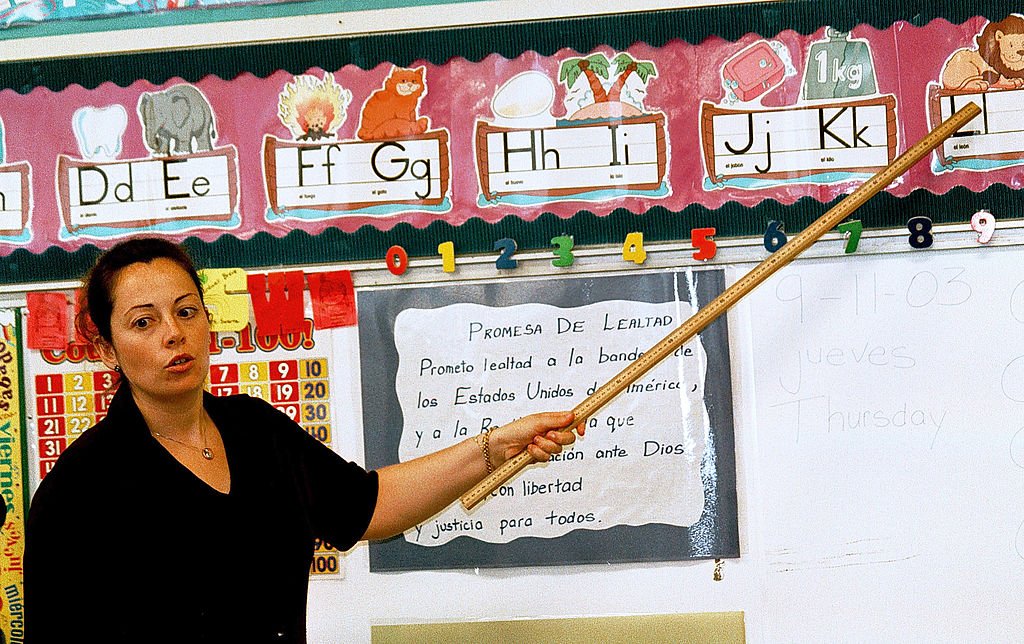Which Congressional Districts Would Lose the Most K–12 Funding Under the Trump and House Education Budgets?
Blog Post

szefei via Shutterstock
Sept. 16, 2025
Note: This piece analyzes the impact of two federal education budget proposals—the Trump administration’s FY 2026 budget and the House of Representatives FY 2026 Appropriations bill—on schools and school systems in each congressional district. The Learning Policy Institute has published an analysis comparing the impact of administration proposal and the Senate’s related proposal on states; that can be found here. EdTrust has published an analysis comparing the impact of all three proposals on school systems; that can be found here. The Urban Institute has created a calculator to show how different budget scenarios would affect states and school districts; that can be found here.
Educators, advocates, and school communities may have felt a sense of déjà vu when the Trump administration put out its 2026 budget proposal. This past July, the administration suddenly refused to pay out large amounts of schools’ promised funding, triggering a budget panic for school systems and an outcry from across the political spectrum. After a few weeks, the Trump education department announced that it would be sending out the money after all. If the administration gets its way on the 2026 budget, though, that reprieve will only be temporary, because the new plan would have nearly the same effect. Just like the funding hold-back in July, the Trump budget would cut over $6 billion from K–12 public education, and would specifically eliminate support for the education of English learners and migrant students, as well as reduce funding for teacher professional development and after-school programs. The President is again coming for schools’ funding.
And while the Senate’s current bipartisan budget bill would mostly keep funding levels the same as the prior year, the Republican proposal advancing in the House of Representatives is another story. It would match several Trump budget cuts, and would also slash a shocking $4.7 billion in Title I funding for students in poverty.
The President is again coming for schools’ funding.
Both the Trump budget proposal and the House Republican proposal would eliminate support for the education of English learners and migrant students, and would reduce funding for teacher professional development and after school programs. Both would cut the most funding from lower-income congressional districts and those that are home to more children of color. Here’s how.
The Trump Budget: K–12 Cuts and Consequences
The Trump budget offers a sobering picture of a slash-and-burn plan for public schools. The budget openly proposes cutting all funding for English language acquisition (often referred to by its section number within the Elementary and Secondary Education Act, Title III, Part A) and Migrant Education (Title I, Part C), as well as grants supporting full-service community schools, educator development, and education innovation and research, among other things.
The Trump budget also proposes taking 18 funding streams—including those supporting rural education, services for students experiencing homelessness, family engagement, and school safety—and consolidating them into a single, “simplified” block grant. Make no mistake: This is a cut. In 2024, these 18 programs provided over $6.5 billion for schools. The Trump budget would “streamline” that funding into a grant worth only $2 billion, a clandestine cut of almost 60 percent. The administration claims to be giving states flexibility. But the funding reduction is likely to mean states and districts won’t have the staff or resources they need to administer these programs well or will skip them entirely, leaving many communities, students, and families without vital services and programs.

A Spanish-speaking first grade teacher instructs a class on the Spanish pronunciations at Birdwell Elementary School.
Source: Photo by Mario Villafuerte/Getty Images
EdTrust has published a look at the estimated impact of these proposed cuts on school systems and has shared this underlying data with New America. (See EdTrust’s methodology here.) We matched the school systems with congressional districts to determine which congressional districts would see their schools lose the most funding.
K–12 Funding Losses by Congressional District Under the President’s Budget
School systems and congressional districts are not drawn along the same lines, so multiple school systems can partially overlap with a single congressional district. By accounting for these different pieces—that is, if 20 percent of a school system falls within a given congressional district, we attribute 20 percent of the school system’s losses to that congressional district—we can estimate how much the schools in each representative’s district would lose if the Trump budget proposal were implemented.
The Trump budget would take an estimated $35.34 million from K–12 schools in each congressional district, on average. This figure is fairly similar between Republican- and Democrat-represented congressional districts. But there is a difference in the specific funding streams most impacted: Democrat-represented districts stand to lose the most in Title I funding for students in poverty and Title III funding for English learners, while Republican-represented districts would lose far more in Title V funding for rural schools. Both would see a major cut in funding for teacher professional development and after-school programs.
There would be a large racial gap in the amount cut. Congressional districts where the school-aged population is predominantly children of color would lose almost double the K–12 funding that districts that are home to mostly white schoolchildren would. This includes close to double the loss of Title II funding for teacher development, more than triple the loss of Title I funding for students in poverty, and almost four times the loss of Title III funding for English learners. Of the 10 percent of congressional districts where the Trump budget would hit schools the hardest, 38 are home to mostly students of color, while only six are majority-white.
The Trump budget would take an estimated $35.34 million from K–12 schools in each congressional district.
If the Trump budget were to pass, there would also be significant income-based disparities in the amount cut. When congressional districts are divided into quartiles by median household income, the districts with the lowest-income families would see their schools lose about $40.7 million on average in 2026, 49 percent more funding than the districts with highest-income families. This includes an estimated loss of nearly ten times the amount of Title V funding for rural schools, which are often in lower-income areas.
In Table 1 below, see the amount of funding that the Trump budget would take from schools in each congressional district, estimated based on the losses of each school system that falls (in whole or in part) within that congressional district. The table shows how much less total funding each district’s schools would see in 2026 than it did in 2023, as well as estimated losses for several specific, key funding streams. Note that these estimates only capture the funding that would be taken from school systems themselves; some federal education funds—especially some Title IV, Part B funding for after-school programs—are given directly to community-based organizations or other recipients, so actual losses would be even larger than those shown here.
The House Republican Appropriations Bill: K–12 Cuts and Consequences
The Republican proposal advancing the House of Representatives answers the president’s call for cuts. Without even hiding behind the smokescreen of “consolidating” funds into block grants, the House proposal would eliminate funding for a number of programs, including Title II funding for educator development and Title III funding for English Learners. It would reduce Title I funding for students in poverty by an astonishing and unprecedented $4.7 billion, slashing a program that is vital for students in every state.
K–12 Funding Losses by Congressional District Under the House Appropriations Bill
The Republican proposal currently advancing through the House would take over $41.2 million from schools in each congressional district, on average—even more than the Trump budget. Perhaps unsurprisingly for a partisan bill, the total funding cuts would be larger in Democrat-represented congressional districts, whose schools would lose over $46.3 million on average, compared to an estimated $36.3 million in Republican-represented districts.
The House Republican proposal would take over $41.2 million from schools in each congressional district, on average—even more than the Trump budget.
There would also be a big racial disparity in funding cuts if the House bill were signed into law. Congressional districts that are home to mostly kids of color would lose an astonishing $57.7 million, on average, while predominantly white congressional districts would see cuts of less than half that, at $26.9 million. Of the 10 percent of congressional districts that would see the largest cuts under the bill, just five are majority-white districts, while 39 have mostly students of color.
If the bill were to become law, schools in lower-income congressional districts would also see far bigger losses than those in richer districts. When congressional districts are divided into quartiles by median household income, schools in the districts with the lowest-income families would see federal funding cuts of $46.1 million on average, 40 percent higher than the losses to districts with the highest-income households.
In Table 2 below, see the amount of funding that the House Republican proposal would take from schools in each congressional district, estimated based on the losses of each school system that falls (in whole or in part) within that congressional district. The table shows how much less total funding each district’s schools would see in 2026 than it did in 2023, as well as estimated losses for some of the funding streams that the bill would specifically target.
School System Losses
The above estimates look at total funding cuts by congressional district; these estimates are composites of the expected funding cuts to the multiple school systems that overlap with each congressional district. Another revealing approach is to measure funding losses to whole school systems, and to see how those school systems relate to congressional districts. If we match each school system to the member of Congress whose district overlaps with that school system to the greatest extent, we can see how the budget proposals would differently affect school systems that are represented in Congress by Democrats and Republicans.
School System Losses Under the Trump Budget
The average U.S. school system would lose over $600,000 in funding under the Trump budget in 2026, or an estimated $212 per student. But these numbers vary a great deal across the country. When it comes to total losses, the average school system represented by a Democrat in Congress stands to lose almost $830,000 overall, compared with $515,000 for the average school system represented by a Republican. But Republican-represented school systems would lose about 91 percent more per pupil. One partial explanation for this is that Republican members of Congress represent many smaller and rural school systems, and the Trump budget would substantially cut Title V funding for the Rural Education Achievement Program.
The 100 school systems whose per-pupil funding would be hardest hit by the Trump budget would see losses of over $3,500 per student, including an estimated $300 per student in Title V alone. Of these 100 school systems, 81 are represented in Congress by Republicans.
School System Losses Under the House Appropriations Bill
The average U.S. school system would lose even more under the House proposal—about $686,000 in total—than under the Trump budget. The average school system represented by a Democrat in Congress would see the bigger total loss—almost $980,000, compared with about $560,000 for the average Republican-represented school system. But in school systems represented by Republicans, the per-pupil loss would be about 61 percent higher than in school systems represented by Democrats.
The 100 school systems that would see the biggest cuts under the House proposal would lose an average of over $2,000 per student, including $389 per student in Title I funding alone. Of these 100 school systems, 79 are represented in the House by Republican members.